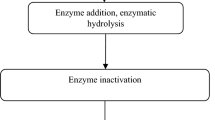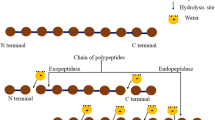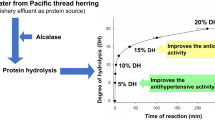Abstract
Bioactive peptides from dietary proteins are used as nutraceuticals. The objective of the investigation is to produce enzymatically hydrolyzed bioactive peptides from the freshwater mussel Anodonta cygnea using commercial food-grade proteases (Alcalase® 2.4 L, and Pepsin). Antibacterial activity of protein hydrolysates against (Escherichia coli, Salmonella typhi, Bacillus subtilis, Staphylococcus aureus, Listeria monocytogenes), FTIR, molecular weight, functional characteristics (protein solubility at different pH, fat absorption, water holding capacities) were evaluated. The degree of hydrolysis increased in higher enzyme concentrations. Hydrolyzed mussel proteins could inhibit some bacterial growth. The hydrolyzed samples by 1 and 6% enzymes showed the highest oil absorption capacity and the 3% treatment had the highest water absorption capacity. By increasing the percentage of enzymes, the solubility of protein increased. The SDS-page results appeared bands less than 2 kD. Our results suggest that swan mussel hydrolysate may be useful as an antibacterial agent, but further studies are needed to exact hydrolysate conditions.
Graphical Abstract








Similar content being viewed by others
Data Availability
All the data mentioned in this paper.
References
Li, Q.Z., Zhou, Z.R., Hu, C.Y., Li, X.B., Chang, Y.Z., Liu, Y., Wang, Y.L., Zhou, X.W.: Recent advances of bioactive proteins/polypeptides in the treatment of breast cancer. Food Sci. Biotechnol. 32, 265–282 (2023). https://doi.org/10.1007/S10068-022-01233-6
Auestad, N., Layman, D.K.: Dairy bioactive proteins and peptides: a narrative review. Nutr. Rev.. Rev. (2021). https://doi.org/10.1093/nutrit/nuab097
Chelliah, R., Wei, S., Banan-MwineDaliri, E., Elahi, F., Yeon, S.-J., Tyagi, A., Liu, S., Hasan Madar, I., Sultan, G., Oh, D.-H., Kim, W.: The role of bioactive peptides in diabetes and obesity. Foods (2021). https://doi.org/10.3390/foods10092220
Haldar, A., Das, M., Chatterjee, R., Dey, T.K.: Functional properties of protein hydrolysates from fresh water mussel Lamellidens marginalis (Lam.). https://www.researchgate.net/publication/325286634_Functional_properties_of_protein_hydrolysates_from_fresh_water_mussel_Lamellidens_marginalis_Lam
Kittiphattanabawon, P., Benjakul, S., Visessanguan, W., Shahidi, F.: Inhibition of angiotensin converting enzyme, human LDL cholesterol and DNA oxidation by hydrolysates from blacktip shark gelatin. LWT 51, 177–182 (2013). https://doi.org/10.1016/J.LWT.2012.10.011
Jayaprakash, R., Perera, C.O.: Partial purification and characterization of bioactive peptides from cooked New Zealand Green-Lipped Mussel (Perna canaliculus) protein hydrolyzates. Foods (2020). https://doi.org/10.3390/foods9070879
Zhang, H., Xia, W.S., Xu, Y.S., Jiang, Q.X., Wang, C.X., Wang, W.J.: Effects of spray-drying operational parameters on the quality of freshwater mussel powder. Food Bioprod. Process.Bioprod. Process. 91, 242–248 (2013). https://doi.org/10.1016/J.FBP.2012.10.006
Zhou, Y., Yi, X., Wang, J., Yang, Q., Wang, S.: Optimization of the ultrasonic-microwave assisted enzymatic hydrolysis of freshwater mussel meat. Int. J. Agric. Biol. Eng. 11, 236–242 (2018). https://doi.org/10.25165/IJABE.V11I5.4104
Hinzmann, M., Bessa, L.J., Teixeira, A., Da Costa, P.M., MacHado, J.: Antimicrobial and antibiofilm activity of unionid mussels from the North of Portugal. J. Shellfish Res. 37, 121–129 (2018). https://doi.org/10.2983/035.037.0110
Wang, X., Yu, H., Xing, R., Li, P.: Characterization, preparation, and purification of marine bioactive peptides. Biomed. Res. Int. (2017). https://doi.org/10.1155/2017/9746720
Zhang, C., Yang, M., Ericsson, A.C.: Antimicrobial peptides: potential application in liver cancer. Front. Microbiol.Microbiol. (2019). https://doi.org/10.3389/FMICB.2019.01257/FULL
AOAC International Official methods of analysis, 18th ed, 2005; Current through revision 2,(On-line). AOAC International, Gaithersburg, MD. (2007).
MOOPAM: Regional Organization for the Protection of the Marine Environment. https://scholar.google.com/scholar?hl=en&as_sdt=0%2C5&q=Moopam+%28Manual+of+oceanographic+observation+and+pollution+analysis%29.1999.+Regional+organization+for+the+protection+of+marine+environment+%28ROPME%2C+Kuwait%29.+220P&btnG=
Shahidi, F., Han, X.Q., Synowiecki, J.: Production and characteristics of protein hydrolysates from capelin (Mallotus villosus). Food Chem. 53, 285–293 (1995). https://doi.org/10.1016/0308-8146(95)93934-J
Diniz, F.M., Martin, A.M.: Effects of the extent of enzymatic hydrolysis on functional properties of shark protein hydrolysate. LWT Food Sci. Technol. 30, 266–272 (1997). https://doi.org/10.1006/FSTL.1996.0184
Chatterjee, R., Dey, T.K., Ghosh, M., Dhar, P.: Enzymatic modification of sesame seed protein, sourced from waste resource for nutraceutical application. Food Bioprod. Process.Bioprod. Process. 94, 70–81 (2015). https://doi.org/10.1016/J.FBP.2015.01.007
Yin, H., Wan, Y., Pu, J., Bechtel, P.J., Sathivel, S.: Functional properties of protein fractions of channel catfish (Ictalurus punctatus) and their effects in an emulsion system. J. Food Sci. 76, E283–E290 (2011). https://doi.org/10.1111/J.1750-3841.2011.02057.X
Laemmli, U.K.: Cleavage of structural proteins during the assembly of the head of bacteriophage T4. Nature 227, 680–685 (1970). https://doi.org/10.1038/227680a0
Ghorbanalizadeh, A., Moshfegh, A., Setorki, M.: Evaluation of antimicrobial activity of peptides isolated from cerastoderma and didacta bivalves habitat in the southern shores of the Caspian Sea. Iran. J. Aquat. Anim. Heal. 4, 1–12 (2018). https://doi.org/10.29252/ijaah.4.1.1
Wald, M., Schwarz, K., Rehbein, H., Bußmann, B., Beermann, C.: Detection of antibacterial activity of an enzymatic hydrolysate generated by processing rainbow trout by-products with trout pepsin. Food Chem. 205, 221–228 (2016). https://doi.org/10.1016/J.FOODCHEM.2016.03.002
Cheong, S.H., Lee, S.-H., Jeon, Y.-J., Lee, D.-S.: Sci-Hub | Mussel (Mytilus coruscus) water extract containing taurine prevents LPS-induced inflammatory responses in zebrafish model. Taurine 10, 931–942 (2017). https://doi.org/10.1007/978-94-024-1079-2_74
Cherifi, H., ChebilAjjabi, L., Sadok, S.: Nutritional value of the Tunisian mussel Mytilus galloprovincialis with a special emphasis on lipid quality. Food Chem. 268, 307–314 (2018). https://doi.org/10.1016/J.FOODCHEM.2018.06.075
Gheorghe, S., Stoica, C., Vasile, G.G., Nita-Lazar, M., Stanescu, E., Lucaciu, I.E.: Metals toxic effects in aquatic ecosystems: modulators of water quality. In: Hlanganani, T. (ed.) Water quality. InTech, London (2017)
Iftikhar Khan, M., Khisroon, M., Khan, A., Gulfam, N., Siraj, M., Zaidi, F., Hira Fatima, S., Noreen, S., Ali Shah, Z., Qadir, F.: Research article bioaccumulation of heavy metals in water, sediments, and tissues and their histopathological effects on Anodonta cygnea (Linea, 1876) in Kabul River. BioMed Res Int (2018). https://doi.org/10.1155/2018/1910274
Pourang, N., Richardson, C.A., Mortazavi, M.S.: Heavy metal concentrations in the soft tissues of swan mussel (Anodonta cygnea) and surficial sediments from Anzali wetland. Iran. Environ. Monit. Assess. 163, 195–213 (2010). https://doi.org/10.1007/S10661-009-0827-7
Yabanlı, M., Katalay, S., Yozukmaz, A., İnanan, B.E.: İzmir Körfezi’nden (Türkiye) yakalanan Mytilus galloprovincialis (Lamarck, 1819)’un sindirim bezi ve solungaçlarındaki ağır metal ve selenyum içeriklerinin karşılaştırması. Turk. J. Biochem. 40, 140–148 (2015). https://doi.org/10.5505/tjb.2015.32448
Cilbiz, N., Hanol, Z.: Evaluation of fisheries wastes as protein hydrolyzate. J. Surv. Fish. Sci. 2, 21–30 (2015). https://doi.org/10.18331/SFS2015.2.1.3
Alahmad, K., Xia, W., Jiang, Q., Xu, Y.: Effect of the degree of hydrolysis on nutritional, functional, and morphological characteristics of protein hydrolysate produced from bighead carp (Hypophthalmichthys nobilis) using ficin enzyme. Foods (2022). https://doi.org/10.3390/foods11091320
Beva, M., Foh, K., Amadou, I., Foh, B.M., Kamara, M.T., Xia, W.: Functionality and antioxidant properties of tilapia (Oreochromis niloticus) as influenced by the degree of hydrolysis. Int. J. Mol. Sci. 11, 1851–1869 (2010). https://doi.org/10.3390/ijms11041851
Halim, N.R.A., Yusof, H.M., Sarbon, N.M.: Functional and bioactive properties of fish protein hydolysates and peptides: a comprehensive review. Trends Food Sci. Technol. 51, 24–33 (2016). https://doi.org/10.1016/J.TIFS.2016.02.007
Fasihnia, S.H., Peighambardoust, S.H., Peighambardoust, S.J.: Nanocomposite films containing organoclay nanoparticles as an antimicrobial (active) packaging for potential food application. J. Food Process. Preserv.Preserv. 42, e13488 (2018). https://doi.org/10.1111/JFPP.13488
Peighambardoust, S.H., Karami, Z., Pateiro, M., Lorenzo, J.M.: Biomolecules a review on health-promoting, biological, and functional aspects of bioactive peptides in food applications. Biomolecules (2021). https://doi.org/10.3390/biom11050631
GolshanTafti, A., Peighambardoust, S.H., Hejazi, M.A., Moosavy, M.H.: Diversity of Lactobacillus strains in Iranian traditional wheat sourdough. J. Food Qual. Hazards Control. 1, 41–45 (2014)
Sen, K., Chattoraj, S.: A comprehensive review of glyphosate adsorption with factors influencing mechanism: kinetics, isotherms, thermodynamics study. Intell. Environ. Data Monit. Pollut. Manag. (2021). https://doi.org/10.1016/B978-0-12-819671-7.00005-1
Andrushchenko, V.V., Vogel, H.J., Prenner, J.: Solvent-dependent structure of two tryptophan-rich antimicrobial peptides and their analogs studied by FTIR and CD spectroscopy. Biomembranes (2006). https://doi.org/10.1016/j.bbamem.2006.07.013
Kafle, B., Böcker, U.B., Wubshet, S.G., Dankel, K., Måge, I., Farrell, M., Afseth, N.K.: Fourier-transform infrared spectroscopy for characterization of liquid protein solutions: a comparison of two sampling techniques enhanced reader. Vib. Spectrosc. Spectrosc 124, 103490 (2023)
Ma, F., Chen, C., Sun, G., Wang, W., Fang, H., Han, Z.: Effects of high pressure and CaCl2 on properties of salt-soluble meat protein gels containing locust bean gum. Innov. Food Sci. Emerg. Technol.. Food Sci. Emerg. Technol. 14, 31–37 (2012). https://doi.org/10.1016/J.IFSET.2011.12.001
Carbonaro, M., Nucara, A.: Secondary structure of food proteins by Fourier transform spectroscopy in the mid-infrared region. Amino Acids 38, 679–690 (2010). https://doi.org/10.1007/S00726-009-0274-3/METRICS
Goormaghtigh, E., de Meutter, J.: FTIR imaging of protein microarrays for high throughput secondary structure determination. Anal. Chem. 93, 3733–3741 (2021). https://doi.org/10.1021/acs.analchem.0c03677
Margulis, B.A., Pinaev, G.P.: The species specificity of the contractile protein composition of the bivalve molluscs. Comp. Biochem. Physiol. Part B Comp. Biochem. 55, 189–194 (1976). https://doi.org/10.1016/0305-0491(76)90228-5
Annamalai, N., Anburaj, R., Jayalakshmi, S., Thavasi, R.: Antibacterial activities of green mussel (Perna viridis) and edible oyster (Crassostrea madrasensis). Res. J. Microbiol.Microbiol. 2, 978–982 (2007). https://doi.org/10.3923/JM.2007.978.982
Grienke, U., Silke, J., Tasdemir, D.: Bioactive compounds from marine mussels and their effects on human health. Food Chem. 142, 48–60 (2014). https://doi.org/10.1016/J.FOODCHEM.2013.07.027
Tsankova, G., Todorova, T., Ermenlieva, N., Merdzhanova, A., Panayotova, V., Dobreva, D., Peytcheva, K.: Antibacterial activity of different extracts of black mussel (Mytilus Galloprovincialis) from the Black Sea. Bulgaria. J. IMAB Annu. Proc. 27, 3506–3509 (2021). https://doi.org/10.5272/jimab.2021271.3506
Acknowledgements
This work has been partly supported by Iran National Science Foundation (INSF).
Funding
This study was funded by Iran National Science Foundation.
Author information
Authors and Affiliations
Corresponding author
Ethics declarations
Conflict of Interest
The authors declare that they have no known conflict of interests.
Additional information
Publisher's Note
Springer Nature remains neutral with regard to jurisdictional claims in published maps and institutional affiliations.
Rights and permissions
Springer Nature or its licensor (e.g. a society or other partner) holds exclusive rights to this article under a publishing agreement with the author(s) or other rightsholder(s); author self-archiving of the accepted manuscript version of this article is solely governed by the terms of such publishing agreement and applicable law.
About this article
Cite this article
Heydari, S., Pourashouri, P., Shabanpour, B. et al. Evaluation of Freshwater Mussel (Anodonta cygnea) Protein Hydrolysates in Terms of Antibacterial Activity and Functional Properties. Waste Biomass Valor (2023). https://doi.org/10.1007/s12649-023-02301-6
Received:
Accepted:
Published:
DOI: https://doi.org/10.1007/s12649-023-02301-6




